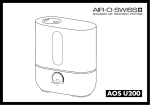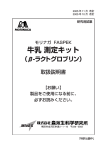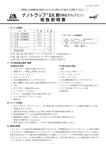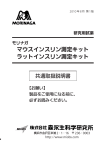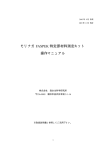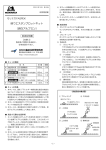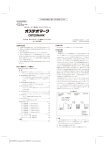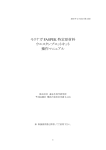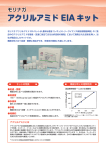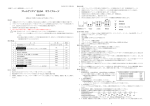Download 共通取扱説明書
Transcript
V.1/Feb/2014 研究用試薬 モリナガ FASPEK エライザⅡ 卵(卵白アルブミン) 牛乳(カゼイン) 小麦(グリアジン) そば 落花生 共通取扱説明書 【お願い】 製品をご使用になる前に、 必ずお読みください。 http://www.miobs.com An instruction in English is from page 17. 目 次 Ⅰ . キットの特長 .................................................................... 3 Ⅱ . キットの構成 .................................................................... 4 Ⅲ . その他必要な器具・装置 .................................................. 4 Ⅳ . 測定原理 ............................................................................ 5 Ⅴ . 測定する際の注意事項 .................................................... 6 Ⅵ . 測定の流れ ........................................................................ 7 Ⅶ . 試薬の調製法 .................................................................... 8 Ⅷ . 抽出法および測定溶液の調製法 .................................. 10 Ⅸ . 測定操作手順 .................................................................. 10 Ⅹ . 特定原材料由来タンパク質濃度の算出法 .................. 12 Ⅺ . 測定のフローチャート .................................................. 14 Ⅻ . 食品反応性情報 .............................................................. 14 ⅩⅢ. 使用上または取扱い上の注意 ................................... 15 ⅩⅣ. キットの保存条件と有効期限 ...................................... 15 ⅩⅤ. 保証 .................................................................................. 15 -2- Ⅰ. キットの特長 1.マイクロプレートを使用したサンドイッチ ELISA 法であるた め特別な施設・設備等を必要とせず、通常の実験室で測定 可能です。 2.従来キット「モリナガ FASPEK 特定原材料測定キット」と同 様に、食品の加工の有無に関わらずタンパク質を高回収率で 抽出できる検体抽出液を使用しています。毒物である 2 -メル カプトエタノールを使わないため、より安全で環境にも優しい キットです。 (特許第3600231号、 特許第5451854号) 3.特定原材料中の対象タンパク質 (下表参照)に対するポリクロー ナル抗体を用いて、食品中に含まれる特定原材料由来の総タン パク質濃度を測定します。 4.測定溶液中の測定タンパク質を 0.78 ng/mL から検出可能 です。 5.イムノクロマトグラフィー法を利用した簡易迅速検出キット「ナ ノトラップ ® Ⅱ R」と共通の検体抽出液を使用しています。 キットのラインアップ キット名 対象タンパク質 測定タンパク質 FASPEK エライザⅡ卵 (卵白アルブミン) 卵白アルブミン 卵総タンパク質 FASPEK エライザⅡ牛乳 (カゼイン) カゼイン 牛乳総タンパク質 FASPEK エライザⅡ小麦 (グリアジン) グリアジン 小麦総タンパク質 FASPEK エライザⅡそば 部分精製 そばタンパク質 そば総タンパク質 FASPEK エライザⅡ落花生 部分精製 落花生総タンパク質 落花生タンパク質 -3- Ⅱ. キットの構成 品 A B C D E F G H I 名 容 A 液(10倍濃縮液) B 液(10倍濃縮液) C 液(10倍濃縮液) 抗体固相化プレート 標準品(50ng/mL) 酵素標識抗体溶液 酵素基質溶液(TMB 溶液) 反応停止液(1N 硫酸)*取扱注意* 洗浄液(20倍濃縮液) プレート用フレーム プレート用ふた 量 数 100mL 1本 100mL 1本 100mL 1本 8 ウェル× 6 本 2 パック 1mL 2本 13mL 1本 13mL 1本 13mL 1本 50mL 1本 − 1個 − 1枚 ※ A 液、B 液、C 液はナノトラップ ® Ⅱ R と共通の試薬です。 Ⅲ . その他必要な器具・装置 1.ミルミキサー 食品を均質化できるもの 2.秤量天秤 食品 1g を秤量できるもの 3.ポリプロピレン製遠心管(50mL) 4.メスシリンダー、プラスチックピペット 5.ボルテックスミキサー 6.振とう機 7.遠心分離機(3,000×g 以上の遠心加速度の出せるもの) 8.ろ紙 9.マイクロピペット(50µL〜1000µL) 10.ポリプロピレン製チューブ(1.5mL) -4- 量 11.プレートリーダー 単波長の場合:450nm 2波長の場合:主波長 450nm・副波長 600〜650 nm 12.マスク、使い捨てプラスチック手袋 Ⅳ . 測定原理 一次反応:測定溶液中の対象タンパク質が、プレート上の固相化 ポリクローナル抗体に結合し、 [固相化抗体 / 対象タ ンパク質]の複合体を形成します。 二次反応:酵素標識ポリクローナル抗体が複合体上の対象タンパ ク質に結合します。 酵素反応:酵素基質溶液を加えると、プレート上の複合体に結 合した酵素により呈色します。得られた吸光度より 特定原材料由来タンパク質濃度を標準曲線から算出 します。 抗体固相化 プレート (調製済み) 一次反応 二次反応 FASPEK エライザⅡの測定原理 -5- 酵素反応 Ⅴ. 測定する際の注意事項 1.キットの試薬には特定原材料由来タンパク質を使用していま す。これらのタンパク質にアレルギーのある方は本キットを使 用する際には試薬の取り扱いに十分に注意し、慎重に測定操 作を行ってください。 2.試薬は全て室温(20〜30℃)に戻してから使用してください。 3.測定は二重測定以上で行ってください。 4.反応時間を厳守して測定してください。 5.標準溶液および測定溶液を分注する際、ピペッティング容量 にばらつきが生じないよう注意してください。マイクロピペット は定期的に校正してください。 6.実験に用いる器具類は汚染が無いよう、使用前に十分洗浄し てください。吸光度のバラツキや、バックグラウンドの上昇の 原因になります。試薬の調製には、使い捨てのプラスチック ピペットや使い捨てチューブなどを使用すると、汚染の可能性 を低減することができます。またウェルへの分注の際に用い るピペットチップはフィルター付きのものをお勧めします。 7.本キットによる測定は非常に高感度なため、埃などが除去さ れた清潔な環境で行ってください。汚染を防ぐため、試薬の 分注後は必ず付属のプレート用ふたをしてください。口や手か らの混入を防ぐため、実験中はマスクや使い捨てのプラスチッ ク手袋等を着用することをお勧めします。 8.各反応終了後の洗浄操作は非常に重要です。洗浄が不十分 だと、バックグラウンドが高くなる可能性があります。ウェル 内に液が残存していないことを十分確認しながら洗浄操作を 行ってください。そのため、アスピレーションによって液を除 いたり、ペーパータオルなどを使用してプレートをよく叩いて 内容液を除いてください。洗浄後は速やかに次の試薬を分注 してください。 -6- 9.酵素反応は遮光下で行ってください。 10.プレートの底は触れないようにしてください。もし指紋等で底 面が曇った場合は、十分に拭き取ってから吸光度を測ってく ださい。汚れで吸光度が正しく測定できない場合があります。 11.本キットは高濃度の界面活性剤や還元剤を含んでおりますの で、使用する際には十分にご注意ください。実験中はマスクや 使い捨てのプラスチック手袋等を着用することをお勧めします。 Ⅵ . 測定の流れ 1 日目 検体抽出液の調製 (「Ⅶ . 試薬の調製法」p.8 参照) ↓ 抽出操作 (「Ⅷ . 抽出法および測定溶液の調製法」p.10 参照) 2 日目 測定溶液の調製 (「Ⅷ . 抽出法および測定溶液の調製法」p.10 参照) ↓ 試薬の調製 (「Ⅶ . 試薬の調製法」p.8 参照) ↓ 測定 (「Ⅸ . 測定操作手順」p.10 参照) ↓ 濃度の算出 (「Ⅹ . 特定原材料由来タンパク質濃度の算出法」 p.12 参照) -7- Ⅶ . 試薬の調製法 1.D 抗体固相化プレートは袋から出さずに室温(20〜30℃)に 戻し、その後開封してください。開封後は直ちに使用してく ださい。 2.以下の試薬は、そのまま使用します。使用前に室温に戻して ください。 E 標準品(50ng/mL) F 酵素標識抗体溶液 G 酵素基質溶液(TMB溶液) H 反応停止液(1N硫酸) 3.検体抽出液の調製 A液(10倍濃縮液)、B液(10倍濃縮液)、C液(10倍濃縮液)、 精製水を 1:1:1:7 の比率で混合します。必要量を調製してくだ さい。 ※A液に沈殿が生じている場合は、加温溶解してからご使用 ください。溶解後は室温で保存可能です。 ※C液は白濁することがありますが、品質上問題はありません。 (例:24検体測定する場合) A液(10倍濃縮液)…………50 mL B液(10倍濃縮液)…………50 mL C液(10倍濃縮液)…………50 mL 精製水 ………………………350 mL 500 mL 4.検体希釈液Ⅰの調製 C液(10倍濃縮液)を精製水で 10倍に希釈します。必要量を 調製してください。 ※ 検体希釈液Ⅱの調製およびろ過液の希釈に用います。 (例:24検体測定する場合) C液(10倍濃縮液)…………50 mL 精製水 ………………………450 mL 500 mL -8- 5.検体希釈液Ⅱの調製 上記 3.で調製した検体抽出液を検体希釈液Ⅰで20倍希釈し ます。必要量を調製してください。 ※標準溶液の調製及び測定溶液の再希釈に用います。 (例:24検体測定する場合) 検体抽出液 …………………25 mL 検体希釈液Ⅰ ………………475 mL 500 mL 6.標準溶液の調製 標準溶液(50, 25, 12.5, 6.25, 3.13, 1.56, 0.78, 0ng/mL)を 調製します。 E 標準品(50ng/mL)を下記に示すように検体希釈液Ⅱ( 「5. 検体希釈液Ⅱの調製」参照)を用いて希釈し、25ng/mL か ら 0.78ng/mL の希釈系列を調製します。 ブランク(0ng/mL)は検体希釈液Ⅱを使用します。 標準溶液 (ng/mL) 50 標準品 1000 検体希釈液Ⅱ 総液量 1000 25 12.5 6.25 3.13 1.56 0.78 0 500 500 500 500 500 500 500 500 500 500 500 500 500 1000 1000 1000 1000 1000 1000 500 (µL) ※標準溶液は用時調製してください。また、測定毎に標準曲線を作成 してください。 7.洗浄液の調製 I 洗浄液(20倍濃縮液)を精製水で 20倍に希釈します。必 要量を調製してください。 ※洗浄操作には調製済み洗浄液を使用します。 -9- Ⅷ . 抽出法および測定溶液の調製法 1.食品をミルミキサー等で粉砕し、均質化操作を行います。 2.均質化した食品 1g をポリプロピレン製遠心管(50mL)にと り、検体抽出液 19mL(「Ⅶ . 試薬の調製法 3. 検体抽出液 の調製」参照)を加え混合します。この際に、あまり泡立た せないよう注意しながら、ボルテックスミキサー等を用いて食 品を分散させます。 3.遠心管を横にして振とう機で一晩(12時間以上)振とうしな がら抽出します。 (90〜110往復/分、 室温、振とう幅 3cm 程度) 。 4.抽出液のpHを確認し、必要であれば中性付近(pH6.0〜8.0) になるよう調整します。 (pH試験紙で結構です。) ※このとき調整に使用したアルカリ(あるいは酸)溶液の液量 を加味し、最終的な特定原材料由来のタンパク質含有量を 算出してください。 5 . 3,000×g で20分間(室温)遠心分離し、上清をろ過し、ろ過液 とします。 6.ろ過液を検体希釈液Ⅰ(「Ⅶ. 試薬の調製法 4. 検体希釈液 Ⅰの調製」参照)を用い20倍に希釈し、測定溶液とします。 (例:ろ過液 50µL に対し、検体希釈液Ⅰ 950µL を添加 します。) 7.更に希釈する場合は、検体希釈液Ⅱ(「Ⅶ . 試薬の調製法 5. 検体希釈液Ⅱの調製」参照)を用い希釈し、測定溶液とし ます。 Ⅸ . 測定操作手順 ・ 全ての試薬は室温(20〜30℃)に戻してから使用してください。 ・ 反応温度は室温で行ってください。 ・ 測定は二重測定以上で行ってください。 ・ ピペッティング容量にばらつきが生じないよう注意してください。 -10- (一次反応) 1.D 抗体固相化プレートを付属のプレート用フレームにセットし ます。 2.各ウェルに標準溶液(0, 0.78〜50ng/mL) 、測定溶液を 100µL ずつ分注します。 3.プレート用ふたをして、室温で正確に 1 時間静置して反応させ ます。 (二次反応) 4.ウェル内の溶液を完全に除去し、ウェルあたり 300µL の洗 浄液で 6 回洗浄します。 5.F 酵素標識抗体溶液を各ウェルに 100µL ずつ分注します。 6.プレート用ふたをして、室温で正確に 30分静置して反応させ ます。 (酵素反応) 7.ウェル内の溶液を完全に除去し、ウェルあたり 300µL の洗 浄液で 6 回洗浄します。 8.G 酵素基質溶液を各ウェルに 100µL ずつ分注します。 9.プレート用ふたをして室温遮光下で正確に 20分間静置して反 応させます。 10.H 反応停止液を各ウェルに 100µL ずつ分注し酵素反応を停 止させます。 11.各ウェルの 450nm および 600〜650nm における吸光度をプ レートリーダーで測定し、各ウェルの 450nm の吸光度から 600〜650nm の吸光度を差し引いた値をそのウェルの吸光度 とします。 注意 酵素反応停止後は30分以内に吸光度を測定してくだ さい。 12.標準溶液の吸光度より標準曲線を作成し、食品中の特定原 材料由来タンパク質濃度を求めます。 ※「Ⅹ . 特定原材料由来タンパク質濃度の算出法」を参照し てください。 -11- Ⅹ. 特定原材料由来タンパク質濃度の算出法 1.測定した各ウェルの吸光度の平均値を算出します。 2.片対数方眼紙を用い、標準溶液の濃度を横軸に、吸光度を 縦軸にプロットし、標準曲線を作成します。また、グラフ描画 ソフトウェアを用いて標準曲線を作成する場合は、4 - パラメー ターを使用することをお勧めします。 3.標準曲線より各測定溶液の濃度を読み取ります。 4.測定溶液の吸光度が標準曲線の吸光度より高い場合は、さ らに希釈して( 「Ⅷ . 抽出法および測定溶液の調製法 7.」参 照) 、再度測定してください。 ※測定溶液の濃度(ng/mL)と、食品中の特定原材料由来タンパク質 含量(µg/g)の関係は次の式で求められます。 µg/g = 測定溶液の濃度[ng/mL]× (抽出時の希釈倍率)× (測定時の希釈倍率) 1,000 -12- 卵(卵白アルブミン) 吸光度(450nm‒620nm) 吸光度(450nm‒620nm) <標準曲線の例> 2.0 1.5 1.0 0.5 0.0 0 1 10 牛乳(カゼイン) 2.0 1.5 1.0 0.5 0.0 100 0 吸光度(450nm‒620nm) 吸光度(450nm‒620nm) 小麦(グリアジン) 2.0 1.5 1.0 0.5 0.0 0 1 10 100 吸光度(450nm‒620nm) 落花生 1.5 1.0 0.5 0.0 10 100 そば 1.5 1.0 0.5 0.0 1 10 標準溶液(ng/mL) 2.0 1 10 2.0 0 標準溶液(ng/mL) 0 1 標準溶液(ng/mL) 標準溶液(ng/mL) 100 標準溶液(ng/mL) -13- 100 Ⅺ . 測定のフローチャート 試薬、測定溶液 □検体抽出液、検体希釈液Ⅰ、検体希釈液Ⅱ及び の調製 洗浄液を調製 標準溶液(0, 0.78〜50ng/mL) 、測定溶液の準備 ↓ (一次反応) □標準溶液、測定溶液(100µL/ ウェル) *測定は二重以上 ↓ □反応(室温、1 時間) ↓ □洗浄(300µL/ ウェル、6 回) ↓ (二次反応) □酵素標識抗体溶液(100µL/ ウェル) ↓ □反応(室温、30分) ↓ □洗浄(300µL/ ウェル、6 回) ↓ (酵素反応) □酵素基質溶液(100µL/ ウェル) ↓ □反応(室温、20分) *遮光下で反応 ↓ (反応停止) □反応停止液(100µL/ ウェル) ↓ (測 定) □吸光度測定 *反応停止後 30分以内に測定 (主波長:450nm、副波長:600〜650nm) Ⅻ . 食品反応性情報 食品反応性データ(偽陰性一覧表含む)は、弊社ホームページ [モリナガ FASPEK エライザⅡ]中の[食品反応性データ]ペー ジ(http://www.miobs.com/product/tokutei/faspek2/reactive. html)をご参照ください。 -14- ⅩⅢ. 使用上または取扱い上の注意 1.有効期限の過ぎたキットは使用しないでください。 2.ロット番号の異なる試薬を組み合わせて使用しないでくださ い。 3.測定の際は必ず標準溶液を同時に測定してください。 4.試薬が誤って目や口に入った場合には、水で十分に洗い流す 等の応急処置を行い、必要があれば医師の診察を受けてくだ さい。 5.キットに組み込まれている試薬類は凍結させないでください。 6.保存中や反応中は強い光にさらさないでください。 7.本キットは食品中の特定原材料由来タンパク質濃度を測定す るための研究用試薬であり、食物アレルギー症状を診断する 臨床検査薬ではありません。本キットによる測定結果とアレ ルギー症状の発症との相関性については確認されておりま せん。 ⅩⅣ. キットの保存条件と有効期限 1.2〜8℃で光の当たらない場所に保管してください。 2.有効期限はラベルに記載してあります。 3.一度開封した試薬は、保管条件により劣化する可能性があり ます。なるべく早く使用してください。 ⅩⅤ. 保 証 1.本キットを使用して得られた結果の評価および利用は、お客 様の責任と判断において行ってください。 2.測定結果を利用し、その結果生じた損害および損失について は、当社は一切責任を負いません。 3.本キット以外の試薬または原材料を使用されて得られた結果 については、当社は一切保証いたしません。 4.万一、試薬に品質上の瑕疵があると当社が判断した場合は、 新しい製品とお取り替えいたします。 -15- -16- Egg (Ovalbumin) ELISA Kit II Casein ELISA Kit II Wheat/Gluten(Gliadin) ELISA Kit II Peanut ELISA Kit II Buckwheat ELISA Kit II The Quantitative Determination for Protein of Allergic Ingredients in Food 96 Assays For Laboratory Use Only. Please read full descriptions in this manual before use. Manufactured by: Morinaga Institute of Biological Science, Inc. (MIoBS) 2-1-16 Sachiura, Kanazawa-ku, Yokohama 236-0003, Japan E-mail: [email protected] Website: http://www.miobs.com/english/index.html Patent pending -17- TABLE OF CONTENTS INTENDED USE AND USER ................................................ 19 PRINCIPLE OF ELISA ......................................................... 19 KIT COMPONENTS ................................................ 20 REQUIRED MATERIALS (NOT INCLUDED) .................... 20 PERFORMANCE CHARACTERISTICS ........................... 20 REAGENT PREPARATION .................................................. 21 ASSAY PROTOCOL ....................................................... 22 Summary of Procedure …............................................ 24 RESULTS AND INTERPRETATION ................................... 25 TYPICAL STANDARD CURVE .................................................... 25 STORAGE CONDITIONS AND EXPIRY OF KIT ............... 26 WARNINGS AND PRECAUTIONS ...................................... 26 Reagent preparation …..................................................... 27 TECHNICAL ASSISTANCE ........................................................... 27 WARRANTY .............................................................................. 27 -18- For optimal results, follow instructions exactly. Failure to do so may lead to inaccurate results. Reproducible results depend on careful pipetting technique, maintaining incubations at the specified temperature for the specified time, complete washing, and thorough mixing of all solutions. INTENDED USE AND USER These ELISA kits are sandwich enzyme immunoassays for the quantitative determination of individual proteins of allergic ingredients in processed or unprocessed food. These kits are designed to be used by quality control personnel or other trained professionals. Table 1 : Detectable protein in each kit Kit Antigen Detectable Protein Egg(Ovalbumin) ELISA Kit II Ovalbumin Whole egg protein Casein ELISA Kit II Casein Whole milk protein Wheat/Gluten(Gliadin) ELISA Kit II Gliadin Whole wheat protein Peanut ELISA Kit II Partially purified peanut protein Whole peanut protein Buckwheat ELISA Kit II Partially purified Buckwheat protein Whole buckwheat protein PRINCIPLE OF ELISA Proteins in the samples are extracted, centrifuged and filtered prior to the sandwich ELISA. Antigen is bound to the polyclonal antibody coated wells of the microplate module. This results in the formation of an antigen-antibody complex in the wells. Unbound materials are removed by washing. Subsequently, the enzyme-conjugated antibody is bound to the already bound antigen-antibody complex, forming an antibody-antigen-antibody sandwich. A second washing step removes the excess conjugated antibody. Addition of enzyme substrate results in color development due to the enzyme bound to the complex. After addition of the stop solution, the color intensity of the solutions can be determined by the absorbance at 450 nm. The intensity of the color developed is directly proportional to the concentration of protein of allergic ingredients in the food. The concentration of its protein corresponding to the measured absorbance is determined by preparing a standard curve, and adjusting for a further dilution factor if necessary. -19- KIT COMPONENTS Label A B C Name of component Reagent A (10X Concentrate) Reagent B (10X Concentrate) Reagent C (10X Concentrate) D Antibody-coated Microplate Module E F G H I Standard (50 ng/mL extracted protein solution) Enzyme-conjugated Antibody Enzyme Substrate (TMB Solution) Stop Solution (1N Sulfuric Acid) Wash Buffer (20X Concentrate) Frame for mounting the microplate module Microplate cover Content 100 mL 100 mL 100 mL 6X8 well modules 1 mL 13 mL 13 mL 13 mL 50 mL Quantity 1 bottle 1 bottle 1 bottle 2 packs 2 vials 1 bottle 1 bottle 1 bottle 1 bottle 1 piece 1 piece REQUIRED MATERIALS (NOT INCLUDED) 1.Distilled water (or deionized water) 2.Micropipettes and disposable tips ranging from 50 to 1000 μL 3.Graduated cylinders 4.Polypropylene centrifuge tubes (50 mL size) for sample extraction 5.Polypropylene micro tubes (1–2 mL size) for preparation of working standard solutions and dilution of sample 6.pH test paper 7.Homogenizer/blender for sample preparation (if necessary) 8.Water bath for boiling or horizontal shaker, for sample extraction 9.Centrifuge 10.Vortex mixer 11.Aspirator for washing procedure, or optional microplate washer 12.Microplate reader with a 450 nm filter, and a filter for any wavelength from 600 to 650 nm, inclusive PERFORMANCE CHARACTERISTICS These ELISA kits are tools to determine the presence of each protein of allergic ingredients in foods such as canned juice, strawberry jam, retorted braised tomatoes and retorted baby food. Sample preparation time Sample extraction time Time for ELISA analysis Assay sensitivity Detectable concentration range Intra-assay precision Repeatability Reproducibility Recovery from model processed food** Approx. 10 min Approx. 30 min, or overnight Approx. 2 h 0.3 μg detectable protein*/g food 0.78 to 50 ng/mL detectable protein* < 10% < 10% < 10% 100+/- 50% * Refer to Table 1 (p.19) for the detectable protein. **Model processed foods were prepared by adding 10 μg/g protein of allergic ingredients to the food before the usual processing. After processing foods, the recovery rate of detectable protein in model processed foods were evaluated using these ELISA kits. -20- REAGENT PREPARATION Sample Extraction Solution Prepare the Sample Extraction Solution by mixing Reagent A (A), Reagent B (B), Reagent C (C) and distilled water at a ratio of 1:1:1:7. The following example would prepare enough Sample Extraction Solution to assay 16 samples: Reagent A (10X Concentrate) (A) 40 mL Reagent B (10X Concentrate) (B) 40 mL Reagent C (10X Concentrate) (C) 40 mL Distilled water 280 mL Total 400 mL Note: a. Reagent A (A) may produce crystals after refrigerated storage. These crystals must be re-dissolved completely in a water bath at 30-37°C (86-99°F) prior to use. The fully re-dissolved Reagent A can be stored at 20-30°C (68-86°F). b. Sample Extraction Solution can be stored at 4°C for preparing Diluent II. If Sample Extraction Solution forms a precipitate after refrigerated storage, then the solution must be warmed in a water bath at 20-30°C (68-86°F) to re-dissolve the precipitate prior to use. Diluent I Diluent I is used for preparing Diluent II and for diluting the Sample Extract. Dilute Reagent C (C) 10-fold with distilled water. The following is an example of preparing Diluent I: 5 mL Reagent C (10X Concentrate) (C) Distilled water 45 mL Total 50 mL Diluent II Diluent II is used to prepare Working Standard, and to further dilute the Working Sample Solution. Dilute Sample Extraction Solution 20-fold with Diluent I. The following is an example of preparing Diluent II: 1 mL Sample Extraction Solution Diluent I 19 mL Total 20 mL Washing Solution Dilute Wash Buffer (I) 20-fold with distilled water, and gently mix until the solution is homogeneous. Standard (50 ng/mL) (E) Standard (50 ng/mL) (E) is used as a 50 ng/mL standard as well as for preparing the diluted working standards described in ASSAY PROTOCOL b. -21- ASSAY PROTOCOL It is strongly recommended to use disposable polypropylene tubes, and care should be taken to clean up all equipments and materials so as to be free from cross-contamination, since the assay is highly sensitive. a. Sample Preparation Extraction of proteins from the test food sample can be performed by two different methods depending on customer’s convenience. (Quick Extraction Method) 1. Grind and mix up the test food sample to homogeneity with a contaminationfree homogenizer/blender. 2. A disposable polypropylene centrifuge tube, containing 1.0 g of the homogenized sample and 19 mL of Sample Extraction Solution, is capped tightly and vortexed for 30 seconds. 3. Expose the capped tube to 100°C (212°F) in boiling water for 10 minutes. 4. Place the tube in running water to cool it down to ambient temperature. It takes some 10 minutes. 5. Vortex the tube for 30 seconds. 6. Check the fluid pH with pH test paper, and neutralize (pH 6-8) with HCl or NaOH, if required. 7. Centrifuge the tube at 3,000×g for 20 minutes at 20-30°C (68-86°F), and the supernatant is retained as Sample Extract. (Filter the supernatant with filter paper, if necessary.) 8. Dilute the Sample Extract by 20-fold with Diluent I (see REAGENT PREPARATION), and the diluted solution is used as the Working Sample Solution for ELISA. Note: If further sample dilution is required, dilute the Working Sample Solution with Diluent II. (Overnight Extraction Method) 1. Grind and mix up the test food sample to homogeneity with a contaminationfree homogenizer/blender. 2. A disposable polypropylene centrifuge tube, containing 1.0 g of the homogenized sample and 19 mL of Sample Extraction Solution, is capped tightly and vortexed for 30 seconds. 3. Fix the capped centrifuge tube to a shaker horizontally, and oscillate at room temperature overnight (for at least 12 hours at 90-110 rpm) with a reciprocating motion of about 3 cm. 4. Follow the procedures 6-8 for Quick Extraction Method. b. Working Standard Preparation 1. Dispense 0.5 mL of Diluent II into six polypropylene micro tubes labeled 0.78, 1.56, 3.13, 6.25, 12.5 and 25 ng/mL. 2. Dispense 0.5 mL of 50 ng/mL Standard (E) into the 25 ng/mL tube, and mix thoroughly. 3. Dispense 0.5 mL of the freshly-prepared 25 ng/mL standard into the 12.5 ng/ mL tube, and mix thoroughly. 4. Repeat this 2-fold dilution series to prepare 6.25, 3.13, 1.56, and 0.78 ng/mL standards. 5. Dispense 0.5 mL of Diluent II into the polypropylene micro tube labeled 0 ng/mL. -22- c. ELISA (First reaction) 1. Unseal the Antibody-coated Microplate Module (D) after equilibrated to room temperature (20-30°C, 68-86°F). Fix the module to the mounting frame (supplied). 2. Into each well, dispense 100 μL of standards (0, 0.78, 1.56, 3.13, 6.25, 12.5, 25 and 50 ng/mL Working Standard) and Working Sample Solution, in (at least) duplicate. Note: Working Sample Solution presumed to be greater than 50 ng/mL should be diluted with Diluent II (ASSAY PROTOCOL a.8, Note). 3. Cover the microplate with a microplate cover (supplied). 4. Incubate for 1 hour at 20-30℃ (68-86°F). (Second reaction) 1. Remove the solution completely from each well by aspiration. (OR: Carefully pour the liquid out of the wells and tap the microplate frame upside down vigorously five times on paper towels to ensure complete removal of liquid from wells.) 2. Wash six times, by adding 300 μL Washing Solution per well followed by aspiration. After washing, remove any remaining solution by inverting and tapping the plate on a clean paper towel. (OR: Fill all the wells (300 μL of the Washing Solution in each), pour out the liquid again and tap. Repeat five more times.) 3. Add 100 μL of Enzyme-conjugated Antibody (F) to each well. 4. Cover the microplate with a microplate cover and incubate for precisely 30 minutes at 20-30°C (68-86°F). (Enzyme reaction) 1. Completely aspirate the well contents and wash six times by filling with 300 μL of Washing Solution per well, and aspirate. After the sixth washing, remove any remaining solution by inverting and tapping the plate on a clean paper towel. (OR: Completely pour the liquid out of the wells, then fill all the wells with 300 μL of the Washing Solution, pour out the liquid again and tap. Repeat five more times.) 2. Immediately, dispense 100 μL of Enzyme Substrate (G). 3. Cover the microplate with the microplate cover and incubate for precisely 20 minutes at 20-30°C (68-86°F). During the enzyme reaction, avoid exposing the microplate to light. 4. Stop the enzyme reaction by adding 100 μL of Stop Solution (H). 5. Immediately measure absorbance using a microplate reader at 450 nm, subtract a reference wavelength between 600 and 650 nm, inclusive. Note: The absorbance must be measured within 30 minutes after stopping the enzyme reaction. -23- Summary of Procedure (Extraction procedure) Grind/mince the samples to homogeneity Weigh 1.0 g ground (or liquid) sample in a clean centrifuge tube, add 19 mL Sample Extraction Solution, cap the tube tightly, and vortex. Quick Extraction Method -- Expose the capped tube to 100°C (212°F) in boiling water for 10 min. -- Cool down the centrifuge tube in running water, and vortex for 30 sec. -- Adjust pH to 6.0-8.0. Overnight Extraction Method -- Fix the capped tube to a shaker horizontally, and oscillate at room temperature overnight (for at least 12 hours at 90-110 rpm) with a reciprocating motion of about 3 cm. -- Adjust pH to 6.0-8.0. Centrifuge at 3,000×g for 20 min at 20-30°C (68-86°F) and filter the supernatant if necessary. Dilute Sample Extract 20-fold with Diluent I (If necessary, dilute further using Diluent II) (ELISA procedure) Attach the Antibody-coated Microplate Module (D) to the mounting frame Pipette 100 μL Working Standard and Working Sample Solution into each well -- Incubate the microplate for 1 hour at 20-30°C (68-86°F) -- Wash the wells 6 times with Washing Solution * Dispense 100 μL Enzyme-conjugated Antibody (F) per well -- Incubate the microplate for 30 min at 20-30°C (68-86°F) -- Wash the wells 6 times with Washing Solution * Dispense 100 μL Enzyme Substrate (G) per well -- Incubate reaction for 20 min at 20-30°C (68-86°F) in the dark Stop the enzyme reaction by adding 100 μL Stop Solution (H) per well Measure absorbance at 450 nm (Subtract the reading at a reference wavelength: any wavelength from 600 to 650 nm, inclusive) Calculate the concentration of detectable protein using the standard curve * The wells are emptied completely by inverting and tapping the microplate on a clean paper towel. -24- RESULTS AND INTERPRETATION 1. Determine the mean absorbance for each set of Working Sample Solution and Working Standard. Use graphing software, the built-in graphing feature of the microplate reader, or graph paper to construct a standard curve by plotting the mean absorbance for each standard on the Y axis versus the corresponding standard concentration on the X axis. Note: A standard curve should be generated for each assay. 2. The detectable protein concentration in the Working Sample Solution is interpolated from the standard curve using the mean absorbance of each observation. 3. If the mean absorbance of Working Sample Solution is greater than the absorbance of the 50 ng/mL standard, increase the dilution of Working Sample Solution to 40-fold or greater as appropriate instead of 20-fold, and then assay again. The detectable protein content in a sample, in μg/g, can be estimated using the following formula: Protein content (μg/g) = OV × Dilution A × Dilution B × 1/1,000 OV: Observed value (ng/mL) Dilution A: Dilution for ASSAY PROTOCOL a.2, nominal 20-fold. Dilution B: Dilution for ASSAY PROTOCOL a.8, nominal 20-fold. TYPICAL STANDARD CURVE Casein 1.5 1.0 0.5 0.0 0 10 20 30 40 2.0 1.5 1.0 0.5 0.0 50 Egg protein standard (ng/mL) 0 ABS (450nm-620nm) ABS (450nm-620nm) 1.0 0.5 0 10 20 30 20 30 40 50 Buckwheat R² = 0.9951 1.5 0.0 10 Milk protein standard (ng/mL) Peanut 2.0 Wheat(Gliadin) R² = 0.9963 ABS (450nm-620nm) R² = 0.9969 ABS (450nm-620nm) ABS (450nm-620nm) Egg(Ovalbumin) 2.0 40 50 Peanut protein standard (ng/mL) 2.0 R² = 0.9983 1.5 1.0 0.5 0.0 0 10 20 30 40 50 Buckwheat protein standard (ng/mL) -25- 2.0 R² = 0.9976 1.5 1.0 0.5 0.0 0 10 20 30 40 50 Wheat protein standard (ng/mL) STORAGE CONDITIONS AND EXPIRY OF KIT 1. Store the kit at 2-8°C (35-46°F), but DO NOT FREEZE! 2. Use the kit at 20-30°C (68-86°F), while minimizing exposure time at this temperature. The kit must be returned to storage at 2-8°C (35-46°F) as soon as possible. Do not expose this kit to temperatures in excess of 30°C (86°F)! 3. Do not use the kit after the expiration date indicated on the outside box. WARNINGS AND PRECAUTIONS (General) 1. Food allergen and bovine serum albumin are used in this kit. Users who are allergic to these proteins should handle kit reagents and perform the assay with great care. In case of an allergic reaction, such as sneezing or itching, seek medical attention if the reaction is serious or prolonged. 2. This product is recommended for use only by personnel trained in analytical sample handling techniques, and is meant to be used in accordance with good laboratory practices. 3. Direct contact with Stop Solution (H) should be strictly avoided. In case of contact, immediately flush affected area with copious amounts of water, and seek medical attention if necessary. In case of ingestion, call the poison control center and obtain first aid treatment. 4. Because all chemicals should be considered potentially hazardous, it is advisable to wear suitable protective clothing, goggles and gloves. 5. Because the assay is highly sensitive, all the procedures should be performed in a clean environment using uncontaminated equipment/devices and tubes/containers in order to minimize the risk of cross-contamination from previous analyses. (ELISA) 1. Do not combine reagents from different lots or other kits. 2. All reagents should be equilibrated at 20-30°C (68-86°F) before use. 3. A standard curve should be generated for each assay concurrently with the samples. 4. Assays should be performed at least in duplicate to ensure confidence in the measured values. 5. Care should be taken to pipette standard solutions and samples accurately. 6. Follow all procedures carefully. 7. Washing must be thorough in order to minimize background readings. Complete removal of reagents from the microplate wells is essential. 8. The enzyme substrate reaction should be performed shielded from light. Note: In the case of processed foods, the detection efficiency or sensitivity of the assay may decrease, due to denaturation and insolubilization of proteins. Therefore, food samples that give a negative result may still contain allergic ingredient which is either unreactive or present at concentrations below the limit of detection. It should not be assumed that such foods are allergic ingredient free. -26- Reagent preparation Reagent Sample Extraction Solution (a) Reagent A Diluent I Diluent II D E F G H Antibody-coated Microplate module Standard (50 ng/mL) Working Standards (0.78, 1.56, 3.13, 6.25, 12.5 and 25 ng/mL) Enzyme-conjugated Antibody Enzyme Substrate Stop Solution Washing Solution Preparation procedure Mix Reagent A (a) , Reagent B, Reagent C and distilled water at a ratio of 1:1:1:7 Equilibrate to 20-30°C (68-86°F), if necessary dissolve any remaining crystals in a water bath at 30-37°C (86-99°F) Dilute Reagent C 10-fold with distilled water Dilute Sample Extraction Solution 20-fold with Diluent I Equilibrate to 20-30°C (68-86°F) before opening Use immediately after opening Equilibrate to 20-30°C (68-86°F) Dilute Standard (50 ng/mL) with Diluent II, sequentially Equilibrate to 20-30°C (68-86°F) Equilibrate to 20-30°C (68-86°F) Avoid exposure to light Equilibrate to 20-30°C (68-86°F) Dilute Wash Buffer 20-fold with distilled water TECHNICAL ASSISTANCE For further technical assistance or troubleshooting advice, contact Morinaga Institute of Biological Science, Inc. or your local distributor. Morinaga Institute of Biological Science, Inc. Telephone: +81-45-791-7674 Fax: +81-45-791-7675 E-mail: [email protected] WARRANTY Morinaga Institute of Biological Science, Inc. makes no warranty of any kind, either expressed or implied, except that the materials from which its products are made are of standard quality. Buyer assumes all risk and liability resulting from the use of this product. There is no warranty of merchantability of the product, or of the fitness of the product for any purpose. Morinaga Institute of Biological Science, Inc. agrees to replace any defective product, but expressly disclaims liability for damages, including special or consequential damages, or expenses arising directly or indirectly from the use of this product. -27- 14




























